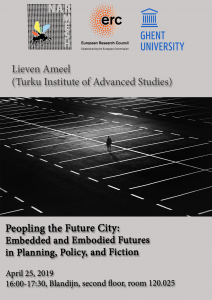This Thursday April 25, 2019 at the Ghent University: “Peopling the Future City: Embedded and Embodied Futures in Planning, Policy, and Fiction”, in collaboration with NARMESH.
16:00-17:30, Blandijn, second floor, room 120.025.
Thanks to Marco Caracciolo and everyone at NARMESH for the invitation.

I’ll be talking about my current research project, in which I examine how different kinds of textual genres, from literary fiction to planning and policy texts, imagine future cities at the water and the possibilities to act towards particular futures, and how they differ in imagining a sense of agency now and in the future.
Literary fiction provides more in the way of qualia, more of a sense of how it feels to be in a particular (future, or speculative) world, than most planning of policy texts set in the same future cities. But how exactly are these experiential, fictional elements situated within the texts, and what meanings do they convey?
One key differentiation that interests me in these different kinds of text is the difference between a panoramic, aestheticizing perspective, and a more grounded, embodied experience.
A second, largely aligned differentiation, is the one between an emptying perspective of the future as field of empty possibility, and the perspective of a future as already in part locked in, and inhabited by embodied and embedded beings within future presents.
While it could be assumed that such differentiations are aligned with the [literary fiction] / [non-fiction; planning & policy] divide, this is not exactly the case, and I examine also planning and policy texts that incorporate fictional elements, as well as fictional texts with a strong emphasis on panoramic perspectives and narrative strategies that in effect empty the future.
In focusing on situated, embedded and embodied experiences of the future, I am indebted to Future Matters (2007) by Barbara Adam and Chris Groves, in which the authors warn against an “emptying of the future” (2), in which the future is “emptied of content and extracted from historical context” (13). They emphasize the importance of approaching the future not in terms of “present futures” – “futures that are imagined, planned, projected, and produced in and for the present” (28), but rather by way of “future presents”, a future that is already partly locked in by our current actions, and peopled with embedded and embodied presents we have the duty to imagine.
Adam and Groves foreground the importance of traditional forms of divination and imaginative methods from futures studies that would allow a focus on “future presents”. Literary fiction can be seen as one important complementary resource for imagining future presents. It has long been emphasized to be crucially about providing readers with qualia – about “how it feels like” to be in a particular, embodied and embedded situation. When so many of the dominant perspectives with which futures are currently imagined take a distancing view, with an emphasis on numbers and quantitative data, on abstract diagrams and on panoramic views of future flood plans or future ice sheet extension, literary resources may allow access to the exact opposite: a sense of what it feels like to be within a situated future present, embedded within particular context and tied to embodied experiences.
Some of my recent articles that are engaged with such questions include “Agency at / in the waterfront in New York City: Vision 2020 and New York 2140” in Textual Practice, and the forthcoming “Governing the Future: Perspectives from Literary Studies”, a reflection paper in the geography journal Fennia (the two previous paragraphs are part of that Fennia paper).
